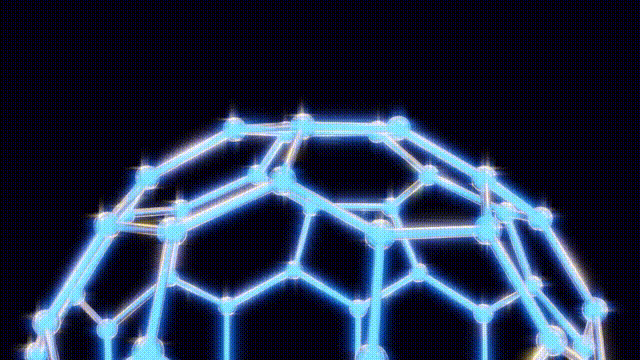Science
Chemists Unveil Buckyballs, Revolutionizing Molecular Science

On November 14, 1985, chemists at Rice University, Houston, Texas, unveiled a groundbreaking discovery: a unique molecule known as buckminsterfullerene, commonly referred to as “buckyballs.” This discovery emerged from a collaboration among three prominent scientists: Harry Kroto, Richard Smalley, and Robert Curl. Their work not only expanded the understanding of carbon structures but also paved the way for numerous applications in fields ranging from materials science to medicine.
The roots of this discovery trace back to the 1970s, when Kroto, a chemist at the University of Sussex, began investigating the unusual presence of organic molecules in interstellar space. During his research, he noted that the radio and light data indicated an abundance of long carbon chains, which seemed inconsistent with existing astrophysical theories. This anomaly prompted scientists to consider whether cooling red giant stars were introducing these carbon chains into the interstellar medium.
A pivotal moment occurred when Kroto visited the laboratories of Smalley and Curl. The team utilized a laser beam to vaporize carbon from a metal disk, cooling the vapor in a helium cloud for analysis. They hypothesized that by substituting the metal with graphite, they could simulate the conditions of a red giant star’s outer shell. Over a focused ten-day period in September, the team successfully produced six- to eight-carbon chains, but they also discovered unexpected forms of carbon—specifically, a molecule made up of 60 carbon atoms.
These 60-carbon structures, dubbed “buckyballs,” exhibited unexpected characteristics. Kroto remarked on the molecule’s unreactive nature, which contradicted previous assumptions about flat graphene sheets. The researchers employed various modeling techniques, including toothpicks and jellybeans, to explore the structure of this molecule.
In a moment of inspiration, Kroto recalled the work of futurist and inventor Buckminster Fuller, particularly his geodesic dome design showcased at the 1967 Expo in Montreal. This connection led the team to finalize the proposed structure of the buckyball, which boasts remarkable symmetry. Their findings were published in the journal Nature on November 14, 1985, marking a significant milestone in molecular science.
As the years progressed, the team expanded their research to better understand the class of molecules known as fullerenes. By 1990, scientists discovered a method to produce these buckyballs in abundance by creating an electric arc between two carbon rods. This advancement further illustrated the potential of fullerenes in various scientific applications.
In recognition of their groundbreaking work, Kroto, Smalley, and Curl were awarded the Nobel Prize in Chemistry in 1996. The implications of their discovery have been far-reaching. Fullerenes, including their chemical relatives known as nanotubes, are celebrated for their exceptional strength and high thermal and electrical conductivity. These properties have made nanotubes invaluable in diverse applications, such as atomic force microscopes, batteries, coatings, and biosensors.
Despite the potential applications of buckyballs in emerging technologies—including quantum computing and drug delivery—mainstream adoption has yet to materialize. The original discovery, however, remains a cornerstone of modern chemistry, inspiring ongoing research into the properties and uses of these remarkable molecules.
The journey of Harry Kroto, Richard Smalley, and Robert Curl exemplifies the power of collaboration and curiosity in scientific discovery. Their work continues to influence various fields, illustrating the profound impact of understanding molecular structures on technology and science.
-

 Lifestyle4 months ago
Lifestyle4 months agoLibraries Challenge Rising E-Book Costs Amid Growing Demand
-

 Sports4 months ago
Sports4 months agoTyreek Hill Responds to Tua Tagovailoa’s Comments on Team Dynamics
-

 Sports4 months ago
Sports4 months agoLiverpool Secures Agreement to Sign Young Striker Will Wright
-

 Lifestyle4 months ago
Lifestyle4 months agoSave Your Split Tomatoes: Expert Tips for Gardeners
-

 Lifestyle4 months ago
Lifestyle4 months agoPrincess Beatrice’s Daughter Athena Joins Siblings at London Parade
-

 World3 months ago
World3 months agoWinter Storms Lash New South Wales with Snow, Flood Risks
-

 Science4 months ago
Science4 months agoTrump Administration Moves to Repeal Key Climate Regulation
-

 Science3 months ago
Science3 months agoSan Francisco Hosts Unique Contest to Identify “Performative Males”
-

 Business4 months ago
Business4 months agoSoFi Technologies Shares Slip 2% Following Insider Stock Sale
-

 Science4 months ago
Science4 months agoNew Tool Reveals Link Between Horse Coat Condition and Parasites
-

 Sports4 months ago
Sports4 months agoElon Musk Sculpture Travels From Utah to Yosemite National Park
-

 Science4 months ago
Science4 months agoNew Study Confirms Humans Transported Stonehenge Bluestones









